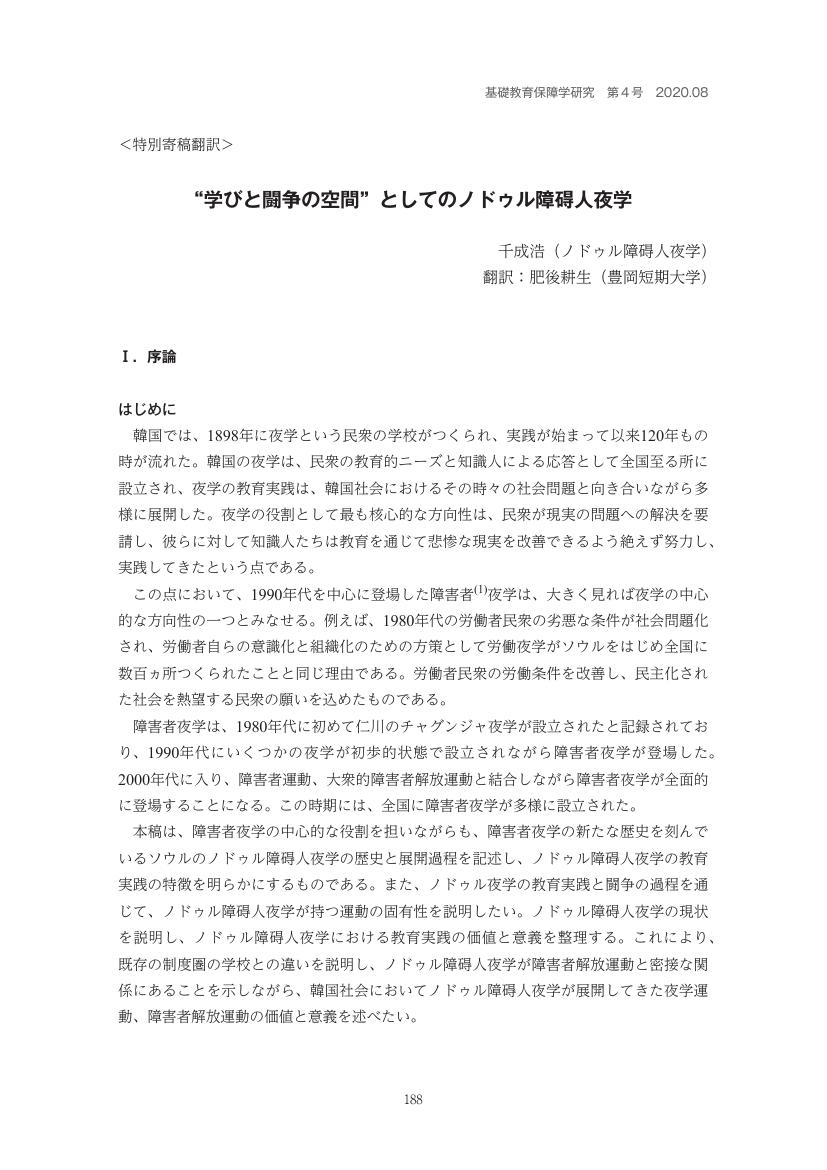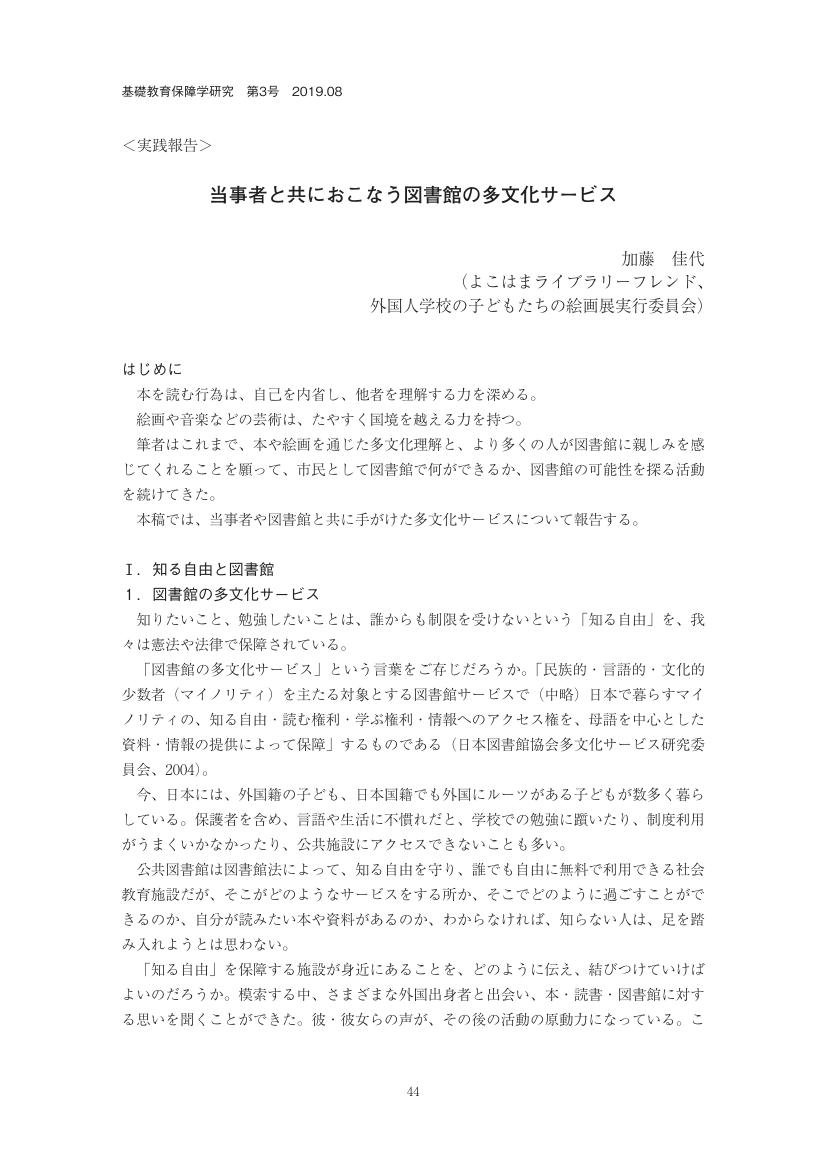5 0 0 0 OA 夜間中学のニーズはいかにして測られるべきか? ─神奈川県ニーズ調査を事例として─
- 著者
- 碓井 健寛
- 出版者
- 基礎教育保障学会
- 雑誌
- 基礎教育保障学研究 (ISSN:24333921)
- 巻号頁・発行日
- vol.4, pp.107-122, 2020 (Released:2020-09-10)
‟Act to Guarantee access to supplementary learning to insufficient compulsory education due to absenteeism and what not‟ has established in 2016. NGO and researchers claimed that the needs surveys for evening junior high school is not enough. The survey is important barometer because it depends on not only the method for investigation of who is and how to estimate the amount of the people with incomplete basic education, and related with the needs what is latent or revealed. It is also difficult for us to grasp what is the intangible nature of the needs at all. I apply to the sociological theory of the social constructivism, and define the needs for the studying in evening junior high school and analyzed and considered from the needs survey held by the education board in Kanagawa prefecture. I found that the people for needs for evening junior high school are more revealed people than other regions when NGO is there for the people from the estimation results.
3 0 0 0 OA 識字調査の意義と課題 ─基礎教育保障の観点から─
- 著者
- 上杉 孝實
- 出版者
- 基礎教育保障学会
- 雑誌
- 基礎教育保障学研究 (ISSN:24333921)
- 巻号頁・発行日
- vol.6, pp.29-46, 2022 (Released:2022-09-15)
This article aims to examine pervious literacy surveys and the change of the definition of literacy among international organizations, and to show what sort of surveys are necessary today. A literacy survey should be based on the expansion of the concept of literacy and its plurality, focusing on the ability to read and write. Its object is to clarify the number of low literate people, their backgrounds and opportunities to learn. Though any national literacy survey has not been conducted, recent local surveys show that there are not a few people who need learning literacy, which has developed as a liberation movement, and stressed the importance of learners’ participation in the management of classes, mutual learning related to their living conditions and comprehension of the relationship between themselves and society. A new literacy survey should assess the ability to communicate including using ICT and physical expression, inquire into the factors which define low literacy, and find opportunities of learning literacy, analyzing the needs of low literate people in detail, whose data are more important than the average mark of people at large.
3 0 0 0 OA 自主夜間中学「えんぴつの会」における 高齢中国帰国者への日本語教育実践報告
- 著者
- 奥元 さえ美
- 出版者
- 基礎教育保障学会
- 雑誌
- 基礎教育保障学研究 (ISSN:24333921)
- 巻号頁・発行日
- vol.4, pp.123-130, 2020 (Released:2020-09-10)
2 0 0 0 OA “学びと闘争の空間” としてのノドゥル障碍人夜学
- 著者
- 千 成浩 肥後 耕生
- 出版者
- 基礎教育保障学会
- 雑誌
- 基礎教育保障学研究 (ISSN:24333921)
- 巻号頁・発行日
- vol.4, pp.188-199, 2020 (Released:2020-09-10)
2 0 0 0 OA 講演録 夜間中学の生活基本漢字381 文字 選定の背景とその指導
- 著者
- 見城 慶和
- 出版者
- 基礎教育保障学会
- 雑誌
- 基礎教育保障学研究 (ISSN:24333921)
- 巻号頁・発行日
- vol.1, pp.84-89, 2017 (Released:2019-07-05)
1 0 0 0 OA 義務教育機会確保法成立前後の東京と神奈川における夜間中学運動
- 著者
- 庄司 匠
- 出版者
- 基礎教育保障学会
- 雑誌
- 基礎教育保障学研究 (ISSN:24333921)
- 巻号頁・発行日
- vol.2, pp.19-25, 2018 (Released:2019-08-19)
- 著者
- 横山 詔一 相澤 正夫 久野 雅樹 高田 智和 前田 忠彦
- 出版者
- 基礎教育保障学会
- 雑誌
- 基礎教育保障学研究 (ISSN:24333921)
- 巻号頁・発行日
- vol.6, pp.11-28, 2022 (Released:2022-09-15)
The first scientific literacy survey in Japan was conducted in 1948. It was the first time that a full-scale nationwide survey based on random sampling techniques was carried out in Japan, and data were collected from 16,820 men and women between the ages of 15 and 64 (by the traditional Japanese system). One of the most well-known aspects of this global landmark survey is the figures on illiteracy rates and their interpretation. The report of the survey, "The reading and writing ability of the Japanese" (1951), concluded that the illiteracy rate of the Japanese was"extremely low" at 1.7% or 2.1%. This view has been cited repeatedly in Japan and abroad and is now treated as a definite fact. However, a reexamination of the content and format of the test questions on the 1948 survey revealed that there was insufficient control of the difficulty level and that the test contained a large number of multiple-choice questions, making it problematic to simply classify those who scored zero on the test as illiterate. Therefore, we concluded that we should avoid uncritically quoting the description of illiteracy rates in this report.
1 0 0 0 OA 当事者と共におこなう図書館の多文化サービス
- 著者
- 加藤 佳代
- 出版者
- 基礎教育保障学会
- 雑誌
- 基礎教育保障学研究 (ISSN:24333921)
- 巻号頁・発行日
- vol.3, pp.44-54, 2019 (Released:2019-08-31)
1 0 0 0 OA リテラシー調査とリテラシー政策を考える ─外国人の日本語リテラシーを中心に─
- 著者
- 前川 喜平
- 出版者
- 基礎教育保障学会
- 雑誌
- 基礎教育保障学研究 (ISSN:24333921)
- 巻号頁・発行日
- vol.6, pp.66-69, 2022 (Released:2022-09-15)
- 著者
- 河内 真美
- 出版者
- 基礎教育保障学会
- 雑誌
- 基礎教育保障学研究 (ISSN:24333921)
- 巻号頁・発行日
- vol.6, pp.88-105, 2022 (Released:2022-09-15)
The purpose of this paper is to explore the concept of functional literacy and changes in its meaning, for the period from the 1950s when it was introduced into UNESCO's literacy strategy to the mid-1970s, by analyzing the relevant UNESCO documents. A while after W. S. Gray advocated the concept, "functional literacy" became the central concept that formed UNESCO's literacy strategy. Gray defined the concept as the knowledge and skills in reading and writing which enable one to engage effectively in various activities in their daily life. After introduced into UNESCO's strategy, the scope of reading and writing activities linked to functional literacy narrowed to one connected with various aspects of development, and then to one connected with economic development, and vocational and technical training in particular. Functional literacy tends to be seen as utilitarian and decontextualized literacy which merely adapt people to existing society. However, the fact that functional literacy used to be linked to people's recreation, critical reading, participation in society, and becoming active agents to build a better society, and that it emphasized the needs and contexts of people and community concerned, shows the great potentiality of the concept.
1 0 0 0 OA 教育機会確保法の成立と私たち
- 著者
- 工藤 慶一
- 出版者
- 基礎教育保障学会
- 雑誌
- 基礎教育保障学研究 (ISSN:24333921)
- 巻号頁・発行日
- vol.2, pp.3-9, 2018 (Released:2019-08-19)
1 0 0 0 OA 未就学者128,187 人に関するカウントデータ分析
- 著者
- 碓井 健寛
- 出版者
- 基礎教育保障学会
- 雑誌
- 基礎教育保障学研究 (ISSN:24333921)
- 巻号頁・発行日
- vol.1, pp.49-60, 2017 (Released:2019-07-05)
Individuals with incomplete basic education have existed for decades, although few studies have clarified their characteristics. Using district-level data from the 2010 Population Census of Japan, this study applied the count data analysis to investigate the characteristics of 128,187 individuals who did not complete basic education. The estimation results suggest that individuals who did not complete basic education have a high probability of remaining unmarried, living on the welfare facility or public housing, or being women of foreign origin. These results have significant policy implications for the national government, suggesting a strong need to gather additional statistical information with regard to individuals who did not complete basic education when the 2020 Population Census of Japan is conducted.





